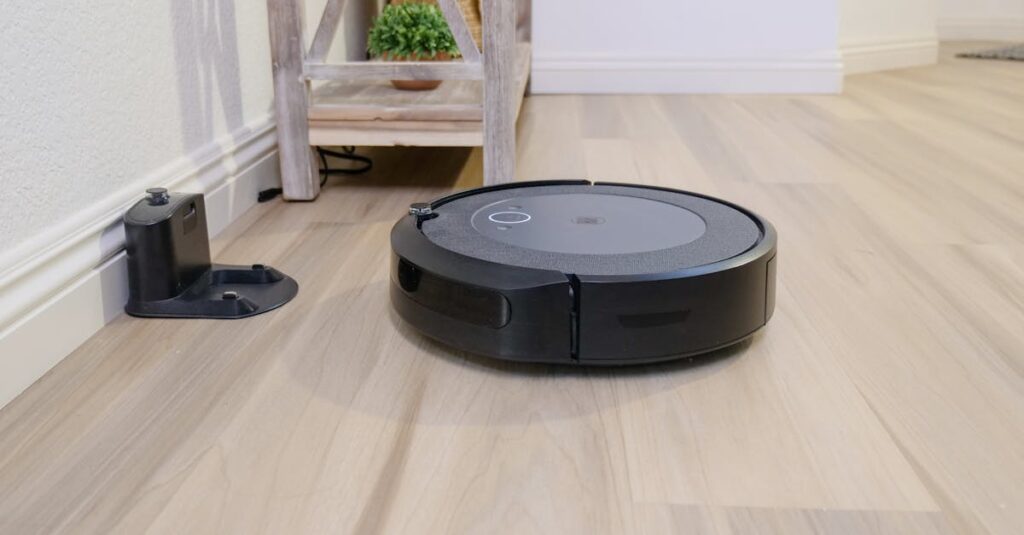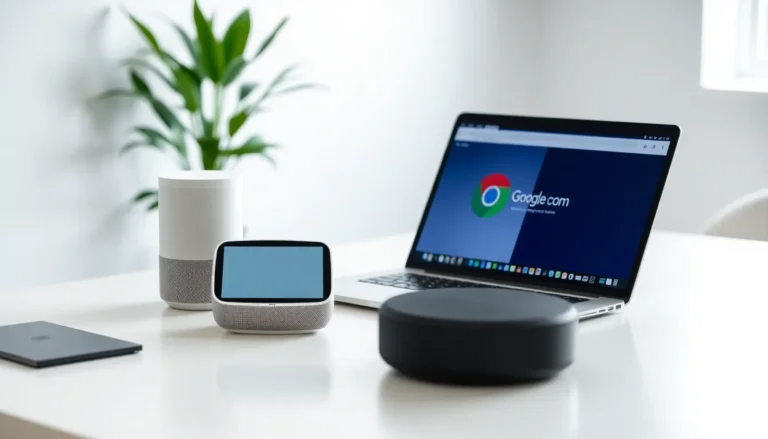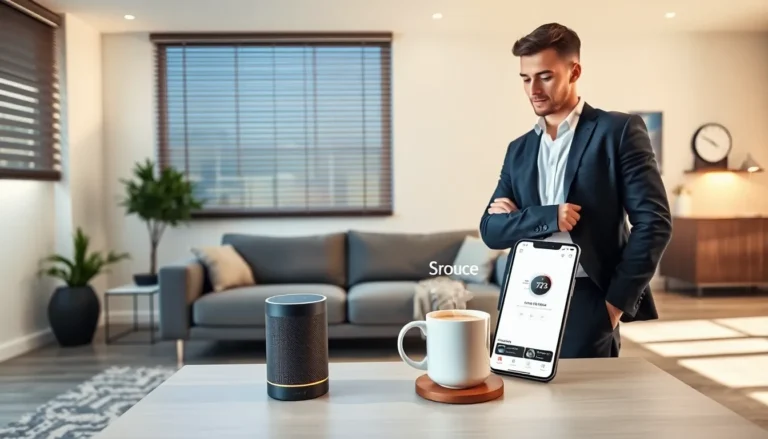Table of Contents
ToggleImagine walking into your home and having it greet you like a long-lost friend. Smart home technology makes that dream a reality, transforming ordinary spaces into futuristic havens. From voice-activated assistants to smart fridges that can order groceries, these gadgets are not just cool; they’re downright life-changing.
Overview of Smart Home Technology
Smart home technology encompasses a range of devices and systems that automate tasks and enhance home management. This technology integrates various elements such as smart lighting, heating, and security systems. Device interconnectivity plays a crucial role, allowing homeowners to control everything from thermostats to cameras via smartphones or voice commands.
Voice-activated assistants like Amazon Alexa, Google Assistant, and Apple HomePod serve as central hubs. These assistants facilitate seamless communication between devices, enabling efficient home management. Users can adjust settings, schedule tasks, and gather information through simple voice commands.
Smart security systems ensure peace of mind by providing real-time monitoring and alerts. Cameras with motion detection and smart doorbell systems allow homeowners to view and interact with visitors from anywhere. Notifications sent to smartphones keep users informed about any unusual activities.
Energy efficiency represents another significant advantage. Smart thermostats, such as the Nest or Ecobee, learn user preferences and adjust temperatures accordingly, leading to reduced energy consumption. These technologies enable homeowners to track and optimize energy usage, resulting in lower utility bills.
In addition to convenience and security, smart home technology enhances the overall living experience. Automated blinds, for example, provide both privacy and energy savings. Smart kitchen appliances like refrigerators recommend recipes based on available ingredients, streamlining meal preparation.
Overall, smart home technology reshapes everyday routines, making life easier and more efficient. As advancements continue, homeowners can expect even more innovative solutions that cater to their needs.
Benefits of Smart Home Technology
Smart home technology offers numerous advantages that improve everyday life. Users experience increased convenience and enhanced security through the integration of these modern devices.
Improved Convenience
Convenience significantly improves with smart home devices. Homeowners can control lighting, temperature, and appliances with voice commands or smartphone apps. Accessibility allows for adjustments from anywhere, even while away from home. Automated routines enable tasks like adjusting thermostats or turning lights off at preset times. Smart kitchen appliances simplify cooking by providing recipe suggestions and managing grocery lists. Continuous connection between devices creates an efficient and user-friendly environment. Ultimately, these innovations minimize manual tasks and contribute to a more manageable lifestyle.
Enhanced Security
Security benefits greatly from smart home technology. Smart security systems provide real-time surveillance and alerts, keeping homeowners informed about potential threats. Cameras and motion sensors detect unusual activity, ensuring swift responses. Remote monitoring enables users to check their property from anywhere, providing peace of mind. Integrated alarm systems enhance protection, triggering alerts immediately upon detection of intrusions. Notifications for doors and windows keep users aware of unauthorized access. Collectively, these features create a robust security network that helps safeguard homes effectively.
Types of Smart Home Devices
Smart home devices encompass a range of technologies designed to enhance convenience, security, and energy efficiency. Each category serves a specific purpose while contributing to an integrated smart home ecosystem.
Smart Lighting
Smart lighting solutions allow homeowners to control brightness and color through smartphones or voice commands. These systems enable scheduling and automation based on individual preferences. With options like LED bulbs that adjust to different hues, users create the desired ambiance in any room. Integration with motion sensors provides additional functionality, automatically turning lights on or off when entering or leaving spaces. Energy-efficient smart lighting can significantly reduce electricity bills, making it both a practical and sustainable choice.
Smart Thermostats
Smart thermostats revolutionize home heating and cooling by learning user habits over time. These devices optimize energy use by adjusting temperatures based on occupancy and preferences. Homeowners can manage settings remotely via mobile apps, ensuring energy savings even when away from home. Integration with weather forecasts allows for proactive adjustments, enhancing comfort and efficiency. Reports generated by smart thermostats provide insights into energy consumption patterns, empowering users to make informed decisions.
Smart Security Systems
Smart security systems enhance home safety with features like real-time monitoring and alerts. Cameras with mobile access enable homeowners to view live footage from anywhere. Motion detectors and door/window sensors provide immediate notifications of any suspicious activity, allowing for swift responses. Integration with smart locks allows users to control entry points remotely, ensuring secure access for family and trusted visitors. Enhanced security features contribute to peace of mind, making smart security systems an essential component of any smart home.
Challenges and Considerations
Smart home technology offers numerous advantages, but understanding the challenges and considerations ensures effective use and implementation.
Privacy Concerns
Privacy issues frequently arise with smart home devices. Data collection practices by manufacturers raise alarms about how personal information gets utilized. Device hacking presents additional risks, potentially compromising security and privacy. Individuals often worry about unauthorized access to live feeds from security cameras and voice recordings from assistants. Beneficial measures include strong passwords and regular software updates, which help secure devices against threats. Users must remain vigilant regarding privacy settings and opt for devices from reputable manufacturers.
Integration Issues
Integration challenges often complicate the smart home experience. Compatibility between different brands and devices can lead to functionality problems. A smart speaker might struggle to connect with certain lighting systems or thermostats, causing frustration. Selecting products that use standard protocols, such as Zigbee or Z-Wave, offers a smoother connection experience. Additionally, frequent updates and firmware installations may disrupt operations, necessitating user engagement. Testing devices before comprehensive deployment ensures they meet specific needs without issues.
Future Trends in Smart Home Technology
Emerging innovations in smart home technology show great promise for enhanced convenience and efficiency. Voice-activated systems continue to evolve, integrating with more devices and services for seamless user experiences. AI-driven automation learns user habits, optimizing energy usage and task management in real-time.
In addition, increased adoption of smart home security solutions reveals a growing focus on protecting personal privacy. Advanced surveillance cameras and smart locks offer enhanced safety features, such as facial recognition and remote access. These technologies provide homeowners with immediate updates on security breaches or unauthorized entries.
Furthermore, sustainability plays a critical role in shaping future smart homes. Energy-efficient appliances and smart thermostats work together to reduce consumption and lower utility costs. Innovative recycling systems and efficient indoor gardens may also become integral components of eco-conscious homes.
Smart home communities are on the rise, fostering collaboration among users. Neighborhood apps facilitate sharing of energy resources and community surveillance, creating a collective sense of security. These platforms also encourage local engagement and help residents stay connected.
Health-focused technology is another area of growth. Smart home devices that monitor air quality or track health metrics empower residents to maintain healthier living environments. Connected wellness devices, such as smart mattresses and fitness trackers, can synchronize data for comprehensive health management.
Overall, future trends in smart home technology indicate a shift toward intelligent automation, heightened security, and sustainable living. As these advancements continue to shape households, the integration of innovative features promises to create more connected and efficient lifestyles.
Smart home technology is revolutionizing the way people live and interact with their environments. With innovations that enhance convenience security and sustainability homeowners are embracing a future where daily tasks are simplified and lifestyles are improved. As technology continues to evolve the focus on privacy and energy efficiency will shape the next generation of smart devices.
The integration of advanced features like AI-driven automation and health monitoring systems will not only make homes smarter but also promote healthier living. As more individuals adopt these technologies the benefits will extend beyond personal comfort to foster community engagement and resource sharing. Embracing smart home solutions today paves the way for a more connected and efficient tomorrow.







